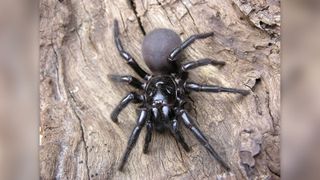
Why does Australia have so many venomous animals?
Scientists explain why animals in Australia wield venom as a weapon.

Australia hosts a dizzying array of venomous creatures — including spiders, snakes, jellyfish, octopuses, ants, bees and even platypuses.
But why do so many Australian animals wield this bioweapon?
Many of these beasties predate Australia as a continent. But it's another story with venomous snakes, which arrived after the continent arose.
Australia became a separate landmass about 100 million years ago when it split from the southern supercontinent Gondwana, said Kevin Arbuckle, an associate professor of evolutionary bioscience at Swansea University in the U.K. The venomous insect lineage is two to three times older than this separation, he told Live Science in an email.
Put another way, some already venomous species simply got stuck on Australia when it became an isolated landmass. Venomous arthropods there include trap-jaw ants (genus Odontomachus), which can inflict a painful bite; but these insects also live in other tropical and subtropical regions around the world, not just Australia. Similarly, Australian bulldog ants (genus Myrmecia), which can simultaneously sting and bite, are among the deadliest ants in the world and have reportedly killed three people since 1936, according to Guinness World Records. These venomous ant lineages were already on Gondwana at the time of separation and stayed there once Australia became its own continent.
As for spiders, funnel-web spiders (genera Hadronyche and Atrax) are the only exclusively Australian ones that can kill humans with a venomous bite, Arbuckle said. Male Sydney funnel-web spiders (Atrax robustus) are thought to have killed 13 people, although no human deaths have been recorded since antivenom was introduced in 1981, according to the Australian Museum. An Australian species of widow spider, the redback (Latrodectus hasselti), can also kill with a venomous bite. Their ancestors, too, predate Australia as a separate continent.
Likewise, venomous cephalopods, including squid, octopus and cuttlefish, have existed for up to 300 million years. They've lived in the surrounding waters for eras before Australia existed on its own.
Related: What's the difference between poison and venom?

Another part of this answer stretches back 60 million years to "an accident of history," according to Michael Lee, a professor of evolutionary biology at the South Australian Museum and Flinders University. Back then, continental drift pushed Australia over the frigid South Pole, which wiped out most of its reptiles. When the continent slowly drifted northward, it warmed up and attracted reptiles once again. By chance, 40 million years after this "accident," the first snakes colonized the continent — and they happened to be from the venomous front-fanged Elapidae family, which includes cobras, mambas, coral snakes and taipans. They became the land's snake ancestors, which then evolved into more venomous snakes.
Of Australia's 220 snake species, 145 are venomous, Lee told Live Science via email. These deadly serpents account for 65% of Australia's snake population, though only about 15% of the world's snakes are venomous.
As for jellyfish, every species is venomous. They also date back over 500 million years and have been floating through the ocean since before Australia existed. While deadly box jellyfish (such as Carukia barnesi) and Portuguese man o' war (Physalia physalis) reside in Australian waters, Arbuckle emphasized that these creatures populate tropical and subtropical waters, not just those Down Under. They're a "not particularly Australian phenomenon," he said. Rather, Australia's coastline fosters an ecosystem fit for these creatures.
Enumerating just how many venomous creatures Australia hosts is difficult.
"The short answer is lots, and probably more than [we] think," Dieter Hochuli, an ecology professor at the University of Sydney, told Live Science in an email.
Aside from snakes, however, Arbuckle argued Australia's venomous fauna are actually well within typical range. "Contrary to popular belief, Australia isn't particularly abundant or diverse in venomous invertebrates," he told Live Science. "Australia has a remarkably enduring and prominent image as the home of highly venomous animals, yet for the most part this is overstated."
He wondered if part of this belief stems from the continent's "scientific capital" and "excellent infrastructure" for public health and medical care.
"Its venomous animal diversity is not unusual at all for a largely tropical area," Arbuckle said.
Sign up for the Live Science daily newsletter now
Get the world’s most fascinating discoveries delivered straight to your inbox.

Elana Spivack is a science writer based in New York City. She has a master's degree from New York University's Science Health and Environmental Reporting Program and a bachelor's from Kenyon College in Ohio. She's written for Inverse, Popular Science, BitchMedia and others.
Most Popular

By Deepa Jain

By Tom Metcalfe

By Deepa Jain